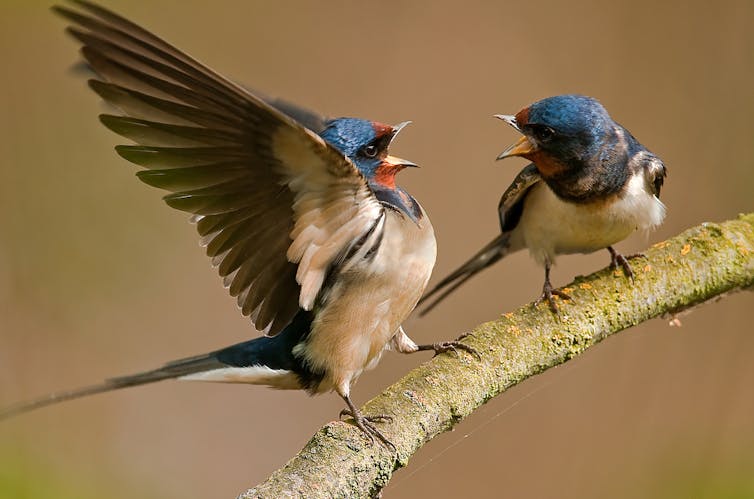Why a proper record of birds in Africa is so important -- for Europe


Most of Europe’s birds head south each year around September to escape the northern winter. Some species only migrate as far south as southern Europe. But most cross the Mediterranean Sea to Africa. And many species cross the Sahara Desert to destinations in West Africa such as Nigeria and in East Africa, such as Kenya. Some travel as far south as South Africa.
These European birds are diligently monitored. Every April, during the breeding season in the early part of the northern summer, teams of citizen scientists in most European countries gather vast amounts of data on the distribution and densities of breeding – for almost every bird species. Thousands of citizen scientists are involved. They diligently generate the data in their leisure time.
Europe is also completing its second atlas of breeding birds. This provides a map, for each species, of the places where it has actually been recorded breeding. With this information resources can be dedicated to protecting the areas where birds breed, and to improving their breeding habitat.
But all this effort is worth little unless it is matched by carefully planned initiatives in the non-breeding season, in Africa. The problem is that there’s not much accurate or up-to-date knowledge about distributions and migration routes in non-breeding areas.
Development – cities, agriculture, mining and industry – is changing the face of Africa. The impact of climate change is predicted to hit Africa harder than any other continent. These factors will certainly affect the bird species that migrate to and from Europe to breed; for many species, more than half the year is spent in Africa.
If Europe is going to reap the benefits of conservation measures at home, the greatest need for research in ornithology that’s relevant to conservation is an understanding of where “their” birds migrate to when they head off to Africa.
That’s where the African Bird Atlas comes in.
Tracking sometimes subtle shifts
Southern Africa has had atlas projects for birds, frogs, reptiles and butterflies. Only the bird atlas was truly comprehensive: almost every corner of Botswana, Lesotho, Namibia, South Africa, Swaziland and Zimbabwe was visited by citizen scientists who collected and compiled all the data.
The first bird atlas was developed in the late 1980s. The participants generated seven million records of bird distribution – a project described as the biggest biodiversity project conducted on the African continent.
A second bird atlas was initiated in 2007 to cover South Africa, Lesotho and Swaziland. This project is ongoing. In August 2017, its database reached 10 million records. It has sister projects, using the same protocol, running in Kenya and Nigeria. Europe focuses on the breeding season, but work on the African bird atlas continues throughout the year. This allows us to gather precious data on the timing of the arrival and departure of migrant birds.
Other countries in Africa such as Ethiopia and Zambia have had bird atlas projects. These were mostly undertaken by expatriate birdwatchers from Europe and North America. While most of the distribution maps produced by these projects are well out of date, they remain incredibly valuable because they help show how distributions have changed.
The two bird atlas projects in southern Africa are a quarter century apart. Many species have shown massive changes in distribution. The Glossy Ibis has expanded westwards. The Maccoa Duck has decreased to the point where it ought to be listed as a threatened species.
The timing of migration is also changing. This is especially true for long-distance migrants. Comparisons between the two bird atlas projects have revealed subtle shifts in the timing of migration to and from South Africa of the iconic bird of the European spring, the Barn Swallow – famous for the saying “one swallow does not make a summer”.
A vital project
So who can get involved in gathering information for the bird atlas, and why should they?
Anyone with a good ability to identify birds in their home can be a citizen scientist for the project. People who think they fit the criteria are encouraged to register as an observer on the project’s website.
The guidelines for participation are all there, including a description of the protocol which needs to be followed. In a nutshell, this involves spending a minimum of two hours in a grid cell, about 9 km square, making a bird list which is as comprehensive as possible. We are currently looking for citizen scientists from across the continent.
All of this work is enormously important for Africa itself. For example, in planning species conservation and setting priorities for action, the first questions asked are: “Where does the species occur?” and “Is this range changing?” Only proper fieldwork through a project like the bird atlas can assure that the answers are not guesswork.
Also, biodiversity tourism – including bird tourism – has huge potential for sustainable employment in Africa. But bird tourism is best planned if there is access to comprehensive distribution maps, especially in the field guides.
![]() And the African Bird Atlas will also be of tremendous use to Europe. A 2014 review showed that Europe’s long distance migrants to Africa are in decline. The weak link in the annual cycle is not clear. The same review points out that we “understand little about distributions patterns” in Africa, and recommends that this is a priority for further research.
And the African Bird Atlas will also be of tremendous use to Europe. A 2014 review showed that Europe’s long distance migrants to Africa are in decline. The weak link in the annual cycle is not clear. The same review points out that we “understand little about distributions patterns” in Africa, and recommends that this is a priority for further research.
Written by Professor Les Underhill, Professor, Biodiversity Informatics, University of Cape Town
This article was originally published on The Conversation. Read the original article.